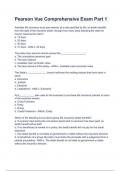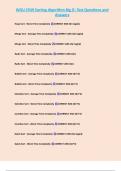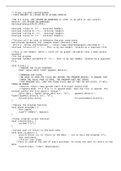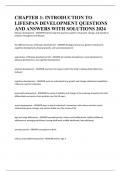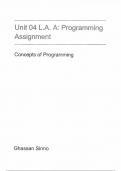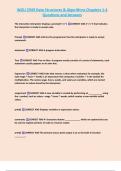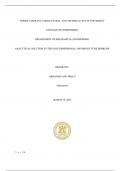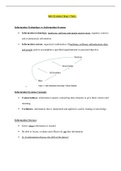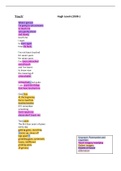ANU31306 – Feed Technology
Week 1
Lecture 1 May 10th Processing impacting nutritional value
Lecture 2 May 11th Processing impacting nutritional value, starches, lipids
Lecture 3 May 12th Processing impacting fibers
Lecture 4 May 12th Processing impacting physical quality aquafeed
Lecture 5 May 12th Processing impacting chicken gut health
Lecture 6 May 14th Processing pet health
Week 4
Lecture 7 May 31st Fundamentals of grinding
Lecture 8 June 1st Fundamentals of mixing and feed additives
Lecture 9 June 2nd Fundamentals of agglomeration
Lecture 10 June 3rd CSI Wageningen (not covered in this summary)
Lecture 11 June 4th Feed mill diagram & carry over
Watch clips processing impacting fibers (Sonja de Vries). Furthermore, brief summary of Carus and
Aeres modules at the end of this lecture summary.
,Week 1 Lecture 1 Processing impacting nutritional value
How should grinding improve feed quality?
- Homogeneous mixtures: contains all nutrients the animal needs
- Inside a grain is what is important (e.g. starch), but the outside contains (undegradable) fibers.
Grinding:
Formation of smaller particles form larger particles.
- Use of mechanical processing (pressure, shear)
Increases particle surface to volume ratio
- Increases accessibility for digestive enzymes
Unlocks nutrients for digestive enzymes
Changes physicochemical properties of particles
- Size, shape, rheological properties, etc.
Does mechanical processing improve nutritional value?
Reducing particle size has varying effects on ADG (average daily growth/gain)
- Depending on cereal grain
- MGD = mean geometric diameter
Reducing particle size improves G:F (grain to feed ratio)
- Depending on cereal grain
- <400 micrometer = no improvements in ADG or G:F
Reducing particle size improves energy digestibility
, Fat à fatty acids
Starch à glucose
Protein à amino acids
Fibre à volatile fatty acids
Ileal digestibility
- Apparent (A)
- Standardised (S)
- True (T)
E.g. High dm intake = lots of base and endogenous losses
E.g. More fiber = increase in endogenous losses
E.g. Coarse material = increase specific endogenous losses
Depends on the type of grain you are looking at, if grinding has an impact on the specific endogenous
losses (SEL).
Reducing particle sizes improves starch accessibility
- Depending on contrast
More fine = more starch digested.
Rate of digestion is improved with more fine materials
Fat is often highly digestible, not well studied yet.
A larger particle size stimulates the gizzard to develop
- Lowers pH (important for pepsin activity and for killing pathogens)
- Stimulates intestinal motility
- Smaller particles into small intestine
- Stimulates pancreatic enzyme secretion
- Stimulates gastro-duodenal refluxes (important for digestive processes as well)
Fineness can have an influence on the health of an animal
Ulceration à Fine diets = more ulcers and erosions compared to a more coarse diet.
Keratinization (eelt) à Coarse diets = more keratinization
It can also have an impact on the performance of the animal if body parts are not healthy
Take home message:
Aiming optimal particle size distribution
- Balancing digestive efficiency and functioning
- How much “structure” is required?
- Pellet quality, production throughput, etc.
Surface area – unlocking nutrients- physicochemical properties
Week 1
Lecture 1 May 10th Processing impacting nutritional value
Lecture 2 May 11th Processing impacting nutritional value, starches, lipids
Lecture 3 May 12th Processing impacting fibers
Lecture 4 May 12th Processing impacting physical quality aquafeed
Lecture 5 May 12th Processing impacting chicken gut health
Lecture 6 May 14th Processing pet health
Week 4
Lecture 7 May 31st Fundamentals of grinding
Lecture 8 June 1st Fundamentals of mixing and feed additives
Lecture 9 June 2nd Fundamentals of agglomeration
Lecture 10 June 3rd CSI Wageningen (not covered in this summary)
Lecture 11 June 4th Feed mill diagram & carry over
Watch clips processing impacting fibers (Sonja de Vries). Furthermore, brief summary of Carus and
Aeres modules at the end of this lecture summary.
,Week 1 Lecture 1 Processing impacting nutritional value
How should grinding improve feed quality?
- Homogeneous mixtures: contains all nutrients the animal needs
- Inside a grain is what is important (e.g. starch), but the outside contains (undegradable) fibers.
Grinding:
Formation of smaller particles form larger particles.
- Use of mechanical processing (pressure, shear)
Increases particle surface to volume ratio
- Increases accessibility for digestive enzymes
Unlocks nutrients for digestive enzymes
Changes physicochemical properties of particles
- Size, shape, rheological properties, etc.
Does mechanical processing improve nutritional value?
Reducing particle size has varying effects on ADG (average daily growth/gain)
- Depending on cereal grain
- MGD = mean geometric diameter
Reducing particle size improves G:F (grain to feed ratio)
- Depending on cereal grain
- <400 micrometer = no improvements in ADG or G:F
Reducing particle size improves energy digestibility
, Fat à fatty acids
Starch à glucose
Protein à amino acids
Fibre à volatile fatty acids
Ileal digestibility
- Apparent (A)
- Standardised (S)
- True (T)
E.g. High dm intake = lots of base and endogenous losses
E.g. More fiber = increase in endogenous losses
E.g. Coarse material = increase specific endogenous losses
Depends on the type of grain you are looking at, if grinding has an impact on the specific endogenous
losses (SEL).
Reducing particle sizes improves starch accessibility
- Depending on contrast
More fine = more starch digested.
Rate of digestion is improved with more fine materials
Fat is often highly digestible, not well studied yet.
A larger particle size stimulates the gizzard to develop
- Lowers pH (important for pepsin activity and for killing pathogens)
- Stimulates intestinal motility
- Smaller particles into small intestine
- Stimulates pancreatic enzyme secretion
- Stimulates gastro-duodenal refluxes (important for digestive processes as well)
Fineness can have an influence on the health of an animal
Ulceration à Fine diets = more ulcers and erosions compared to a more coarse diet.
Keratinization (eelt) à Coarse diets = more keratinization
It can also have an impact on the performance of the animal if body parts are not healthy
Take home message:
Aiming optimal particle size distribution
- Balancing digestive efficiency and functioning
- How much “structure” is required?
- Pellet quality, production throughput, etc.
Surface area – unlocking nutrients- physicochemical properties

